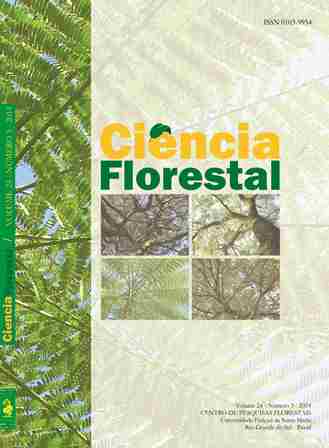Ver ítem
- xmlui.general.dspace_homeCentros Regionales y EEAsCentro Regional MisionesEEA MontecarloArtículos científicosxmlui.ArtifactBrowser.ItemViewer.trail
- Inicio
- Centros Regionales y EEAs
- Centro Regional Misiones
- EEA Montecarlo
- Artículos científicos
- Ver ítem
Efecto del raleo sobre el crecimiento y la densidad de la madera de Pinus taeda implantado en Misiones, Argentina = Effect of thinning treatment on growth and wood density of Pinus taeda planted in Misiones, Argentina
Resumen
El mayor incremento en crecimiento de la plantación puede causar variación en las propiedades físicas de la madera, pudiendo disminuir la calidad de la misma para la industria. El objetivo del presente trabajo es evaluar el efecto de los tratamientos de raleo sobre el crecimiento y densidad de la madera de Pinus taeda implantado en Misiones, Argentina (25º 59’S - 54º24’O). La plantación se estableció en 1985 con densidad inicial de 1644 pl.ha-1y se manejó
[ver mas...]
El mayor incremento en crecimiento de la plantación puede causar variación en las propiedades físicas de la madera, pudiendo disminuir la calidad de la misma para la industria. El objetivo del presente trabajo es evaluar el efecto de los tratamientos de raleo sobre el crecimiento y densidad de la madera de Pinus taeda implantado en Misiones, Argentina (25º 59’S - 54º24’O). La plantación se estableció en 1985 con densidad inicial de 1644 pl.ha-1y se manejó con tres intensidades de raleo (0, 33 y 66 % del área basal del testigo sin ralear), bajo un diseño de bloques completos al azar (3 bloques). A los 20 años se efectuó tala rasa, cuyas densidades eran 711 (0 %), 364 (33 %) y 122 (66 %) plantas por hectárea, momento en el cual se seleccionaron 45 árboles para determinar la densidad básica de la madera. La misma se determinó a través de la realización de 2.700 probetas. El crecimiento de la plantación fue afectado por la intensidad de raleo, registrando diámetros promedio de 28,7, 34,8 y 45,9 cm, respectivamente, en los tratamientos 0, 33 y 66 % de raleo. El volumen de la plantación, al momento del apeo, fue superior en el tratamiento sin raleo, no obstante el tratamiento 66 % de raleo generó mayor cantidad de madera de grandes dimensiones.
La densidad básica como promedio simple y ponderado por volumen no presentó diferencias significativas
entre tratamientos. Los valores de densidad ponderada fueron de 0,406, 0,418 y 0,420 g.cm-3 para los
tratamientos 0, 33 y 66 % de raleo, respectivamente, mientras que el análisis de correlación entre diámetro
y densidad no fue significativo. El estudio mostró que la intensidad de raleo puede ser manejada para
maximizar la producción, manteniendo idéntica la calidad de la madera para la industria.
[Cerrar]
The greatest increase in growth of the plantation may change the physical properties of wood, and therefore may decrease the wood quality for industry. The current paper aimed to evaluate the effect of thinning treatments on growth and wood density of Pinus taeda planted in Misiones, Argentina (25º 59’ S - 54º24’ W). The plantation was established in 1985 with 1644 plants per hectare and three thinning intensity treatments
were used (0%, 33% and 66% of
[ver mas...]
The greatest increase in growth of the plantation may change the physical properties of wood, and therefore may decrease the wood quality for industry. The current paper aimed to evaluate the effect of thinning treatments on growth and wood density of Pinus taeda planted in Misiones, Argentina (25º 59’ S - 54º24’ W). The plantation was established in 1985 with 1644 plants per hectare and three thinning intensity treatments
were used (0%, 33% and 66% of the remaining basal area), under design randomized complete blocks (3 blocks). The harvest was performed at rotation age (20 years-old), on parcels with 711(0%), 364 (33%) and 122 (66%) plants per hectare. Forty-five trees were selected to determine the basic wood density (15 trees per treatments, 2700 samples). Thinning significantly affected the growth of the plantation, with average diameters of 45.9 cm, 34.8cm and 28.7 cm in 0%, 33% and 66% thinning treatments, respectively. The volume of the plantation was higher in the unthinned treatment, while 66 % thinning produced a deficiently place occupation, generating greater amounts of large wood. For simple and weighted wood density the
differences between thinning treatments were not significant. The weighted density values were 0.406, 0.418 and 0.420 g.cm-3 for 0%, 33% and 66% thinning treatments, respectively. The correlation analysis carried out between the diameter and density was not significant. The intensity of thinning can be managed to maximize the production without any modification in the wood quality for industry.
[Cerrar]

Autor
Martiarena, Rodolfo;
Crechi, Ernesto Hector;
Pinazo, Martin Alcides;
Von Wallis, Alejandra;
Marquina, Jorge;
Monteoliva, Silvia Estela;
Fuente
Ciência Florestal, Santa Maria 24 (3) : 655-663. (Jul.-set., 2014)
Fecha
2014
ISSN
0103-9954
1980-5098 (Online)
1980-5098 (Online)
Formato
pdf
Tipo de documento
artículo
Palabras Claves
Derechos de acceso
Abierto
 Excepto donde se diga explicitamente, este item se publica bajo la siguiente descripción: Creative Commons Attribution-NonCommercial-ShareAlike 2.5 Unported (CC BY-NC-SA 2.5)
Excepto donde se diga explicitamente, este item se publica bajo la siguiente descripción: Creative Commons Attribution-NonCommercial-ShareAlike 2.5 Unported (CC BY-NC-SA 2.5)


